Financial Analysis and Reporting
VerifiedAdded on 2020/03/23
|10
|2185
|29
AI Summary
This assignment tasks you with analyzing a provided financial report of a New Zealand company. You need to explain various aspects including borrowings (mortgage and bank loan), asset revaluation reserve, issued and paid-up capital, and retained earnings. The analysis should reference relevant NZ FRS guidelines for clarity and accuracy.
Contribute Materials
Your contribution can guide someone’s learning journey. Share your
documents today.
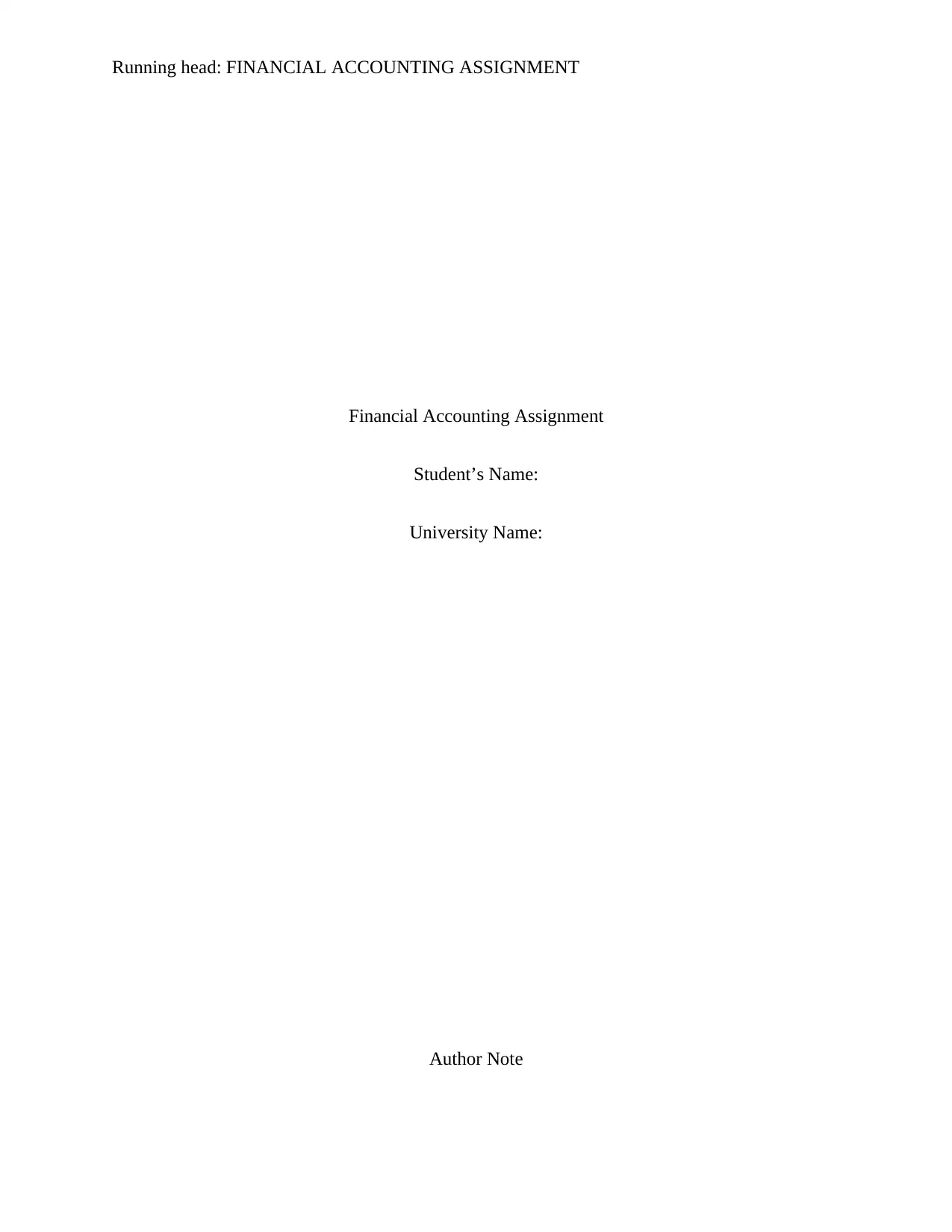
Running head: FINANCIAL ACCOUNTING ASSIGNMENT
Financial Accounting Assignment
Student’s Name:
University Name:
Author Note
Financial Accounting Assignment
Student’s Name:
University Name:
Author Note
Secure Best Marks with AI Grader
Need help grading? Try our AI Grader for instant feedback on your assignments.

1FINANCIAL ACCOUNTING ASSIGNMENT
STATEMENT OF PROFIT OR LOSS AND OTHER COMPREHENSIVE INCOME
Sales 161500 190400
Revenue 1
Commission and Royalties received 6200 9520
Investment income(Dividends
Received) 714 756
Total revenue 168414 200676
Expenses
Operating Expenses 2 -130634 -153046
Accumulated Depriciation
Land & Buildings -63000 -69000
Plant & Manufacturing Equipment -12500 -16200
Office Equipment -1300 -1400
Vehicles -420 -650
Operating Profit/Profit before Tax 128974 161056
Income Tax Expense 3 -5040 -7830
Net Profit after Tax 123934 153226
STATEMENT OF CHANGES IN EQUITY
STATEMENT OF CHANGES IN EQUITY for the financial
year ended 30th june, 2016
Particulars Notes
Share
Capital
Retained
Earnings
Asset
Revaluation
Reserve
Opening balance 140000 42500 850
(+)Net Profit for the year 117734
TOTAL 4 160234
(-)Dividend
STATEMENT OF PROFIT OR LOSS AND OTHER COMPREHENSIVE INCOME
Sales 161500 190400
Revenue 1
Commission and Royalties received 6200 9520
Investment income(Dividends
Received) 714 756
Total revenue 168414 200676
Expenses
Operating Expenses 2 -130634 -153046
Accumulated Depriciation
Land & Buildings -63000 -69000
Plant & Manufacturing Equipment -12500 -16200
Office Equipment -1300 -1400
Vehicles -420 -650
Operating Profit/Profit before Tax 128974 161056
Income Tax Expense 3 -5040 -7830
Net Profit after Tax 123934 153226
STATEMENT OF CHANGES IN EQUITY
STATEMENT OF CHANGES IN EQUITY for the financial
year ended 30th june, 2016
Particulars Notes
Share
Capital
Retained
Earnings
Asset
Revaluation
Reserve
Opening balance 140000 42500 850
(+)Net Profit for the year 117734
TOTAL 4 160234
(-)Dividend
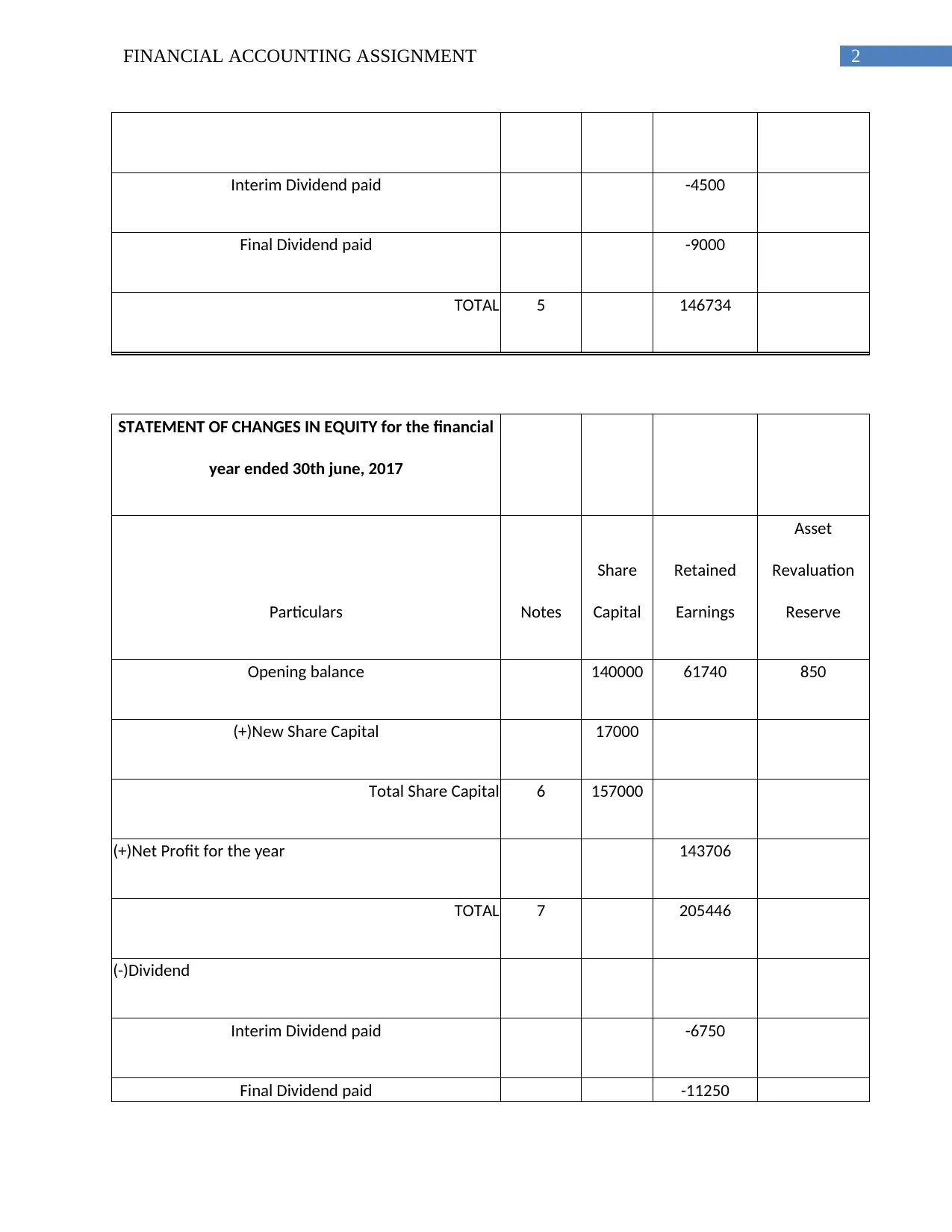
2FINANCIAL ACCOUNTING ASSIGNMENT
Interim Dividend paid -4500
Final Dividend paid -9000
TOTAL 5 146734
STATEMENT OF CHANGES IN EQUITY for the financial
year ended 30th june, 2017
Particulars Notes
Share
Capital
Retained
Earnings
Asset
Revaluation
Reserve
Opening balance 140000 61740 850
(+)New Share Capital 17000
Total Share Capital 6 157000
(+)Net Profit for the year 143706
TOTAL 7 205446
(-)Dividend
Interim Dividend paid -6750
Final Dividend paid -11250
Interim Dividend paid -4500
Final Dividend paid -9000
TOTAL 5 146734
STATEMENT OF CHANGES IN EQUITY for the financial
year ended 30th june, 2017
Particulars Notes
Share
Capital
Retained
Earnings
Asset
Revaluation
Reserve
Opening balance 140000 61740 850
(+)New Share Capital 17000
Total Share Capital 6 157000
(+)Net Profit for the year 143706
TOTAL 7 205446
(-)Dividend
Interim Dividend paid -6750
Final Dividend paid -11250
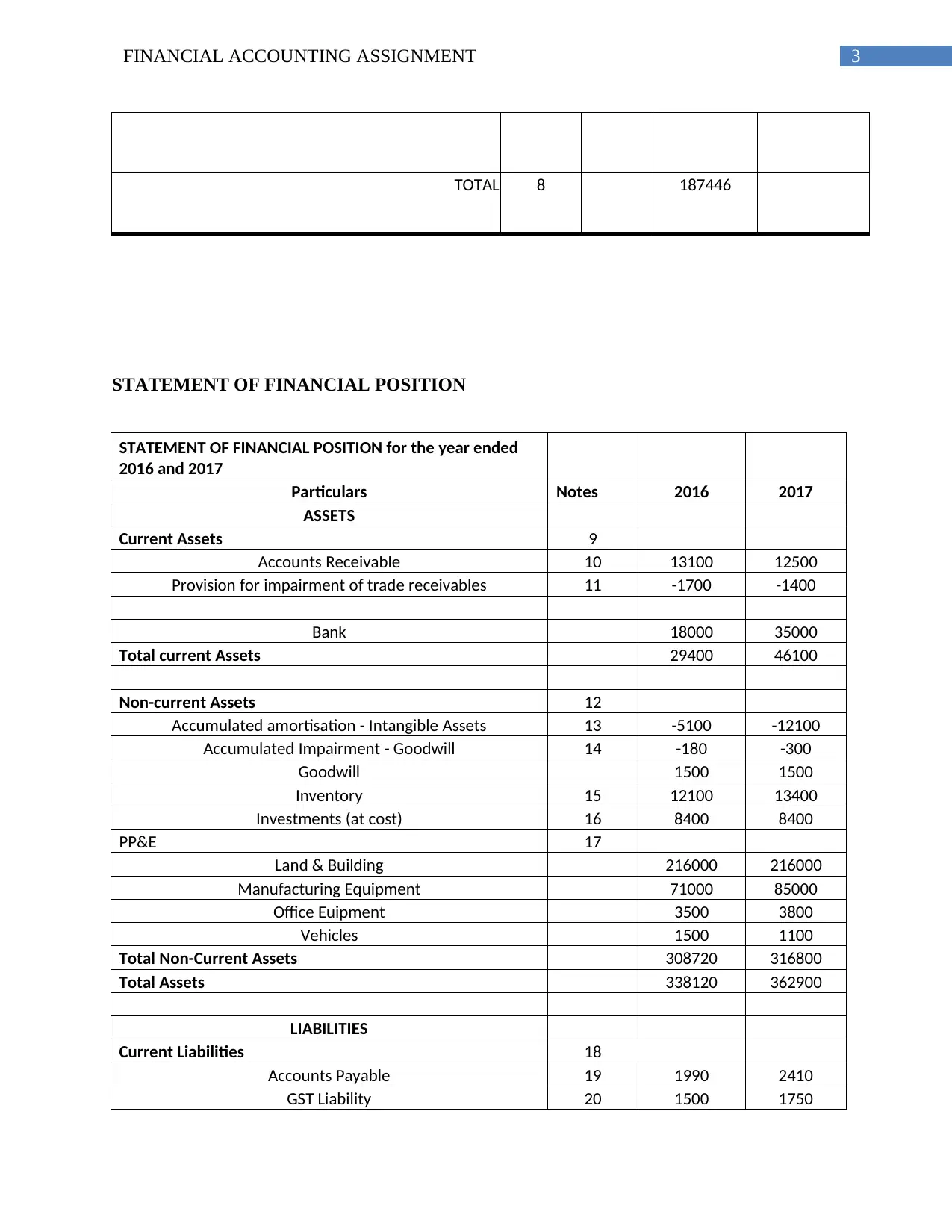
3FINANCIAL ACCOUNTING ASSIGNMENT
TOTAL 8 187446
STATEMENT OF FINANCIAL POSITION
STATEMENT OF FINANCIAL POSITION for the year ended
2016 and 2017
Particulars Notes 2016 2017
ASSETS
Current Assets 9
Accounts Receivable 10 13100 12500
Provision for impairment of trade receivables 11 -1700 -1400
Bank 18000 35000
Total current Assets 29400 46100
Non-current Assets 12
Accumulated amortisation - Intangible Assets 13 -5100 -12100
Accumulated Impairment - Goodwill 14 -180 -300
Goodwill 1500 1500
Inventory 15 12100 13400
Investments (at cost) 16 8400 8400
PP&E 17
Land & Building 216000 216000
Manufacturing Equipment 71000 85000
Office Euipment 3500 3800
Vehicles 1500 1100
Total Non-Current Assets 308720 316800
Total Assets 338120 362900
LIABILITIES
Current Liabilities 18
Accounts Payable 19 1990 2410
GST Liability 20 1500 1750
TOTAL 8 187446
STATEMENT OF FINANCIAL POSITION
STATEMENT OF FINANCIAL POSITION for the year ended
2016 and 2017
Particulars Notes 2016 2017
ASSETS
Current Assets 9
Accounts Receivable 10 13100 12500
Provision for impairment of trade receivables 11 -1700 -1400
Bank 18000 35000
Total current Assets 29400 46100
Non-current Assets 12
Accumulated amortisation - Intangible Assets 13 -5100 -12100
Accumulated Impairment - Goodwill 14 -180 -300
Goodwill 1500 1500
Inventory 15 12100 13400
Investments (at cost) 16 8400 8400
PP&E 17
Land & Building 216000 216000
Manufacturing Equipment 71000 85000
Office Euipment 3500 3800
Vehicles 1500 1100
Total Non-Current Assets 308720 316800
Total Assets 338120 362900
LIABILITIES
Current Liabilities 18
Accounts Payable 19 1990 2410
GST Liability 20 1500 1750
Secure Best Marks with AI Grader
Need help grading? Try our AI Grader for instant feedback on your assignments.
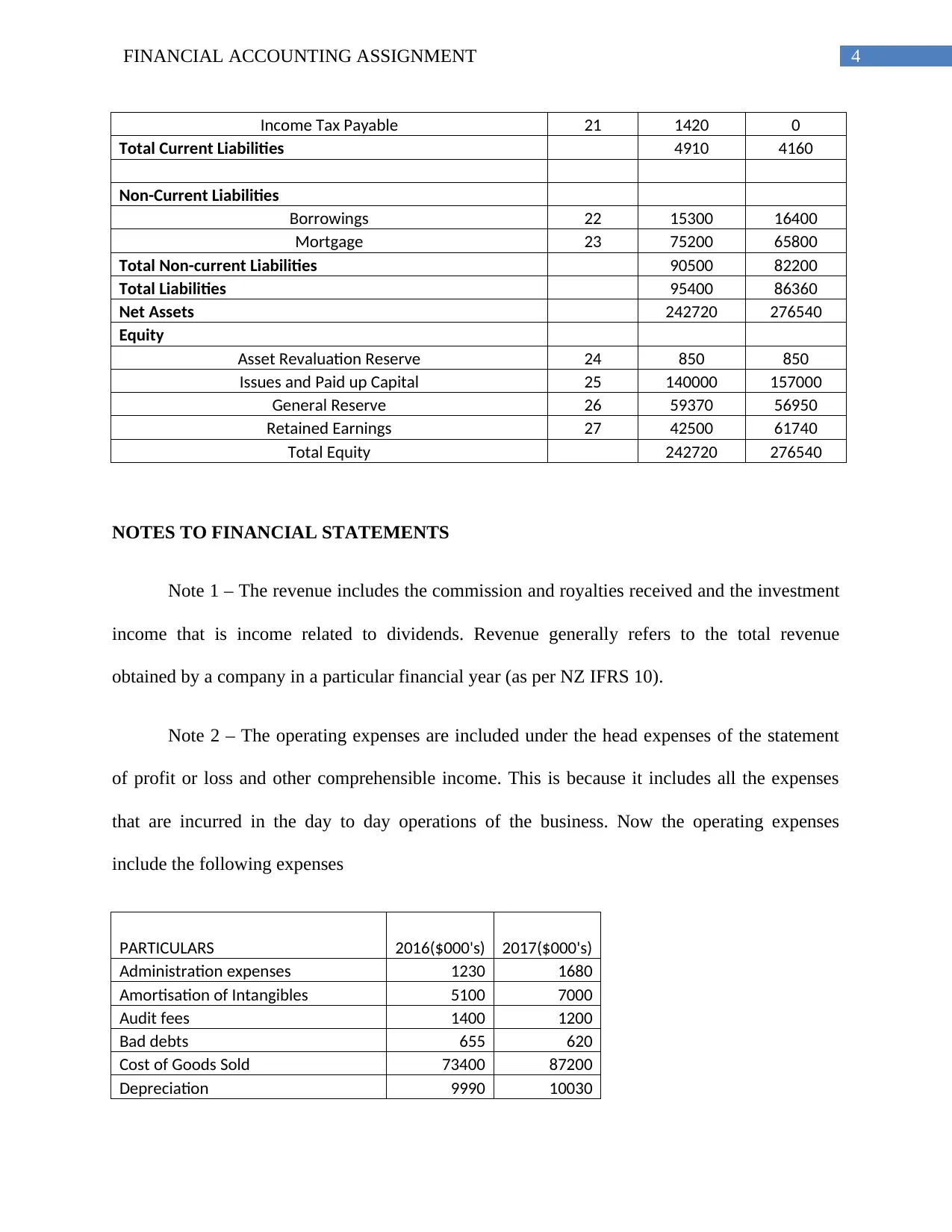
4FINANCIAL ACCOUNTING ASSIGNMENT
Income Tax Payable 21 1420 0
Total Current Liabilities 4910 4160
Non-Current Liabilities
Borrowings 22 15300 16400
Mortgage 23 75200 65800
Total Non-current Liabilities 90500 82200
Total Liabilities 95400 86360
Net Assets 242720 276540
Equity
Asset Revaluation Reserve 24 850 850
Issues and Paid up Capital 25 140000 157000
General Reserve 26 59370 56950
Retained Earnings 27 42500 61740
Total Equity 242720 276540
NOTES TO FINANCIAL STATEMENTS
Note 1 – The revenue includes the commission and royalties received and the investment
income that is income related to dividends. Revenue generally refers to the total revenue
obtained by a company in a particular financial year (as per NZ IFRS 10).
Note 2 – The operating expenses are included under the head expenses of the statement
of profit or loss and other comprehensible income. This is because it includes all the expenses
that are incurred in the day to day operations of the business. Now the operating expenses
include the following expenses
PARTICULARS 2016($000's) 2017($000's)
Administration expenses 1230 1680
Amortisation of Intangibles 5100 7000
Audit fees 1400 1200
Bad debts 655 620
Cost of Goods Sold 73400 87200
Depreciation 9990 10030
Income Tax Payable 21 1420 0
Total Current Liabilities 4910 4160
Non-Current Liabilities
Borrowings 22 15300 16400
Mortgage 23 75200 65800
Total Non-current Liabilities 90500 82200
Total Liabilities 95400 86360
Net Assets 242720 276540
Equity
Asset Revaluation Reserve 24 850 850
Issues and Paid up Capital 25 140000 157000
General Reserve 26 59370 56950
Retained Earnings 27 42500 61740
Total Equity 242720 276540
NOTES TO FINANCIAL STATEMENTS
Note 1 – The revenue includes the commission and royalties received and the investment
income that is income related to dividends. Revenue generally refers to the total revenue
obtained by a company in a particular financial year (as per NZ IFRS 10).
Note 2 – The operating expenses are included under the head expenses of the statement
of profit or loss and other comprehensible income. This is because it includes all the expenses
that are incurred in the day to day operations of the business. Now the operating expenses
include the following expenses
PARTICULARS 2016($000's) 2017($000's)
Administration expenses 1230 1680
Amortisation of Intangibles 5100 7000
Audit fees 1400 1200
Bad debts 655 620
Cost of Goods Sold 73400 87200
Depreciation 9990 10030
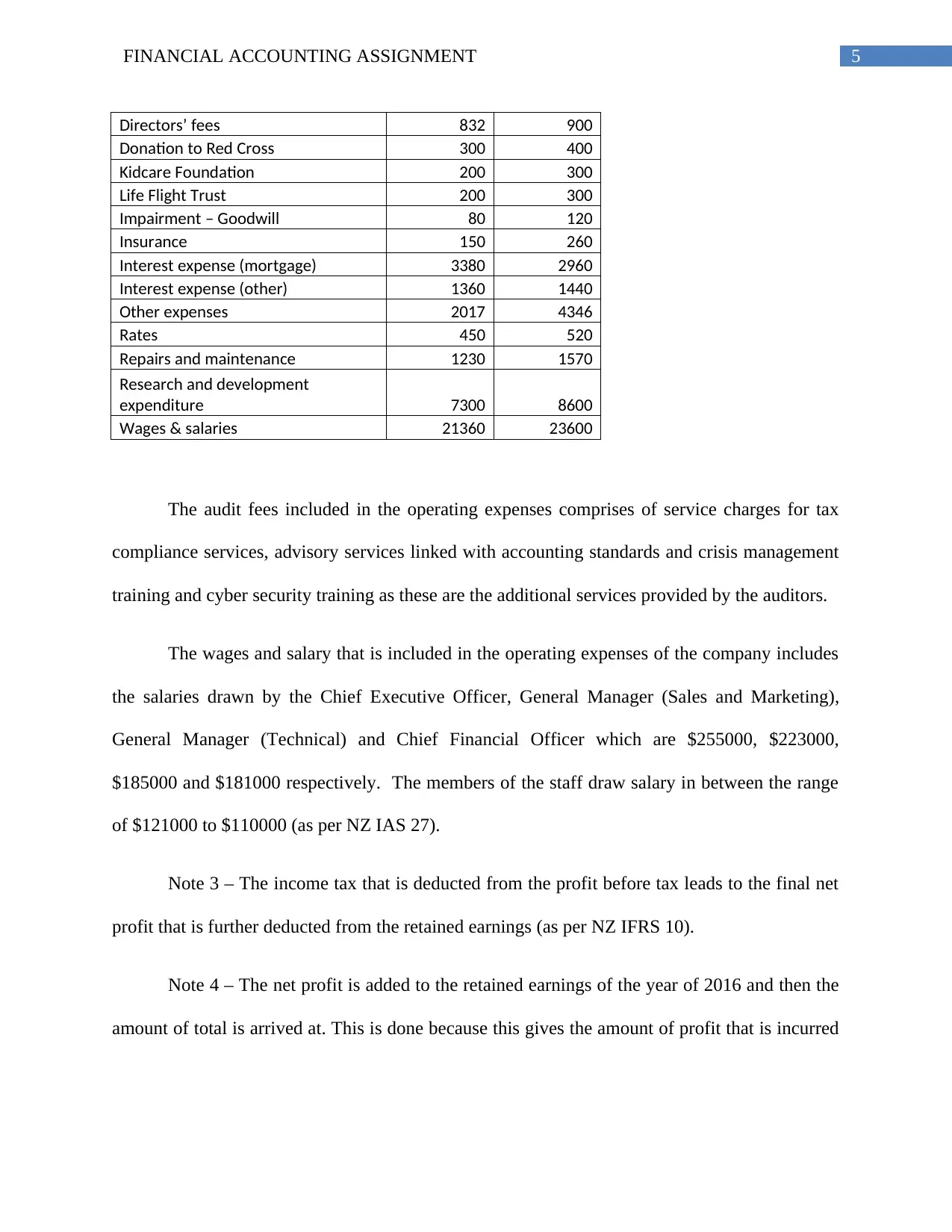
5FINANCIAL ACCOUNTING ASSIGNMENT
Directors’ fees 832 900
Donation to Red Cross 300 400
Kidcare Foundation 200 300
Life Flight Trust 200 300
Impairment – Goodwill 80 120
Insurance 150 260
Interest expense (mortgage) 3380 2960
Interest expense (other) 1360 1440
Other expenses 2017 4346
Rates 450 520
Repairs and maintenance 1230 1570
Research and development
expenditure 7300 8600
Wages & salaries 21360 23600
The audit fees included in the operating expenses comprises of service charges for tax
compliance services, advisory services linked with accounting standards and crisis management
training and cyber security training as these are the additional services provided by the auditors.
The wages and salary that is included in the operating expenses of the company includes
the salaries drawn by the Chief Executive Officer, General Manager (Sales and Marketing),
General Manager (Technical) and Chief Financial Officer which are $255000, $223000,
$185000 and $181000 respectively. The members of the staff draw salary in between the range
of $121000 to $110000 (as per NZ IAS 27).
Note 3 – The income tax that is deducted from the profit before tax leads to the final net
profit that is further deducted from the retained earnings (as per NZ IFRS 10).
Note 4 – The net profit is added to the retained earnings of the year of 2016 and then the
amount of total is arrived at. This is done because this gives the amount of profit that is incurred
Directors’ fees 832 900
Donation to Red Cross 300 400
Kidcare Foundation 200 300
Life Flight Trust 200 300
Impairment – Goodwill 80 120
Insurance 150 260
Interest expense (mortgage) 3380 2960
Interest expense (other) 1360 1440
Other expenses 2017 4346
Rates 450 520
Repairs and maintenance 1230 1570
Research and development
expenditure 7300 8600
Wages & salaries 21360 23600
The audit fees included in the operating expenses comprises of service charges for tax
compliance services, advisory services linked with accounting standards and crisis management
training and cyber security training as these are the additional services provided by the auditors.
The wages and salary that is included in the operating expenses of the company includes
the salaries drawn by the Chief Executive Officer, General Manager (Sales and Marketing),
General Manager (Technical) and Chief Financial Officer which are $255000, $223000,
$185000 and $181000 respectively. The members of the staff draw salary in between the range
of $121000 to $110000 (as per NZ IAS 27).
Note 3 – The income tax that is deducted from the profit before tax leads to the final net
profit that is further deducted from the retained earnings (as per NZ IFRS 10).
Note 4 – The net profit is added to the retained earnings of the year of 2016 and then the
amount of total is arrived at. This is done because this gives the amount of profit that is incurred

6FINANCIAL ACCOUNTING ASSIGNMENT
in a particular financial year including the dividend that has to be paid to different stakeholders
of business (as per NZ IFRS 10).
Note 5 – The interim dividend and final dividend paid is subtracted from the retained
earnings in order to get the final amount of revenue that is really incurred by a company in the
financial year (as per NZ IFRS 10).
Note 6 – In the statement of changes in equity the share capital in the year of 2017
increases by the amount of $17000. This is because in the year of 2017 new share capital was
issued by the company. This also indicates the fact that the company is doing enough profit and
its reputation among the investors is increasing which is why more shares are purchased by them.
Thus the new increased share capital becomes $157000.
Note 7 – Again the net profit is added in the same way as in the year of 2016 for the same
reason and the total amount is arrived at (as per NZ IFRS 10).
Note 8 – In the similar kind of way the dividends are subtracted in order to arrive at the
amount of total revenue earned for this particular financial year.
Note 9 – In the balance sheet of the company the total current asset of the company is
recorded, that is the assets that are used by the firm in the daily operations of business.
Note 10 - In note 10 the accounts receivable is recorded. It is generally a current asset .
Note 11 – In note 11 the provision for impairment of trade receivables is recorded as a
current asset, as this is a provision that offsets the accounts receivables in the financial
statements. A particular debtor owes the company a certain sum of money (as per NZ IFRS 10).
in a particular financial year including the dividend that has to be paid to different stakeholders
of business (as per NZ IFRS 10).
Note 5 – The interim dividend and final dividend paid is subtracted from the retained
earnings in order to get the final amount of revenue that is really incurred by a company in the
financial year (as per NZ IFRS 10).
Note 6 – In the statement of changes in equity the share capital in the year of 2017
increases by the amount of $17000. This is because in the year of 2017 new share capital was
issued by the company. This also indicates the fact that the company is doing enough profit and
its reputation among the investors is increasing which is why more shares are purchased by them.
Thus the new increased share capital becomes $157000.
Note 7 – Again the net profit is added in the same way as in the year of 2016 for the same
reason and the total amount is arrived at (as per NZ IFRS 10).
Note 8 – In the similar kind of way the dividends are subtracted in order to arrive at the
amount of total revenue earned for this particular financial year.
Note 9 – In the balance sheet of the company the total current asset of the company is
recorded, that is the assets that are used by the firm in the daily operations of business.
Note 10 - In note 10 the accounts receivable is recorded. It is generally a current asset .
Note 11 – In note 11 the provision for impairment of trade receivables is recorded as a
current asset, as this is a provision that offsets the accounts receivables in the financial
statements. A particular debtor owes the company a certain sum of money (as per NZ IFRS 10).
Paraphrase This Document
Need a fresh take? Get an instant paraphrase of this document with our AI Paraphraser
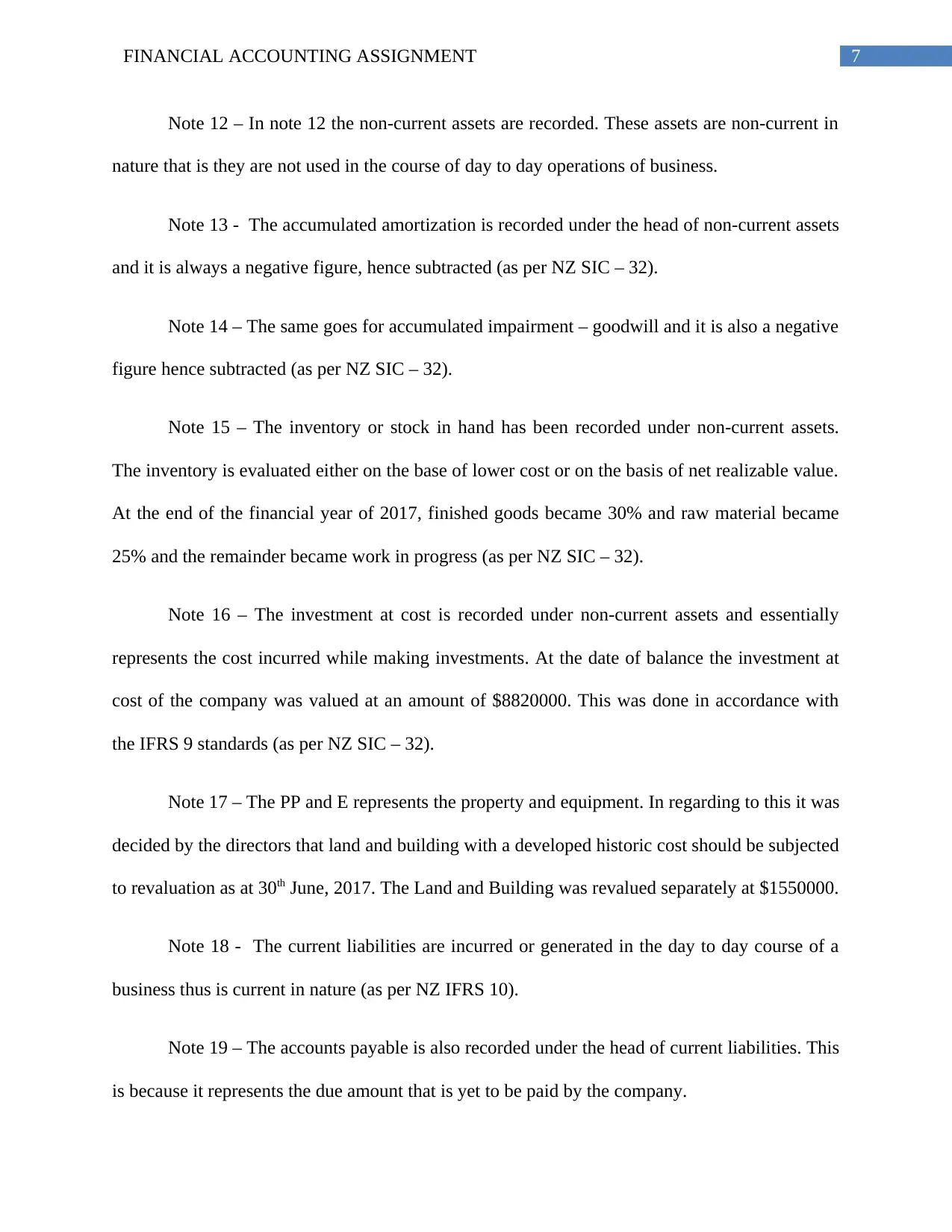
7FINANCIAL ACCOUNTING ASSIGNMENT
Note 12 – In note 12 the non-current assets are recorded. These assets are non-current in
nature that is they are not used in the course of day to day operations of business.
Note 13 - The accumulated amortization is recorded under the head of non-current assets
and it is always a negative figure, hence subtracted (as per NZ SIC – 32).
Note 14 – The same goes for accumulated impairment – goodwill and it is also a negative
figure hence subtracted (as per NZ SIC – 32).
Note 15 – The inventory or stock in hand has been recorded under non-current assets.
The inventory is evaluated either on the base of lower cost or on the basis of net realizable value.
At the end of the financial year of 2017, finished goods became 30% and raw material became
25% and the remainder became work in progress (as per NZ SIC – 32).
Note 16 – The investment at cost is recorded under non-current assets and essentially
represents the cost incurred while making investments. At the date of balance the investment at
cost of the company was valued at an amount of $8820000. This was done in accordance with
the IFRS 9 standards (as per NZ SIC – 32).
Note 17 – The PP and E represents the property and equipment. In regarding to this it was
decided by the directors that land and building with a developed historic cost should be subjected
to revaluation as at 30th June, 2017. The Land and Building was revalued separately at $1550000.
Note 18 - The current liabilities are incurred or generated in the day to day course of a
business thus is current in nature (as per NZ IFRS 10).
Note 19 – The accounts payable is also recorded under the head of current liabilities. This
is because it represents the due amount that is yet to be paid by the company.
Note 12 – In note 12 the non-current assets are recorded. These assets are non-current in
nature that is they are not used in the course of day to day operations of business.
Note 13 - The accumulated amortization is recorded under the head of non-current assets
and it is always a negative figure, hence subtracted (as per NZ SIC – 32).
Note 14 – The same goes for accumulated impairment – goodwill and it is also a negative
figure hence subtracted (as per NZ SIC – 32).
Note 15 – The inventory or stock in hand has been recorded under non-current assets.
The inventory is evaluated either on the base of lower cost or on the basis of net realizable value.
At the end of the financial year of 2017, finished goods became 30% and raw material became
25% and the remainder became work in progress (as per NZ SIC – 32).
Note 16 – The investment at cost is recorded under non-current assets and essentially
represents the cost incurred while making investments. At the date of balance the investment at
cost of the company was valued at an amount of $8820000. This was done in accordance with
the IFRS 9 standards (as per NZ SIC – 32).
Note 17 – The PP and E represents the property and equipment. In regarding to this it was
decided by the directors that land and building with a developed historic cost should be subjected
to revaluation as at 30th June, 2017. The Land and Building was revalued separately at $1550000.
Note 18 - The current liabilities are incurred or generated in the day to day course of a
business thus is current in nature (as per NZ IFRS 10).
Note 19 – The accounts payable is also recorded under the head of current liabilities. This
is because it represents the due amount that is yet to be paid by the company.
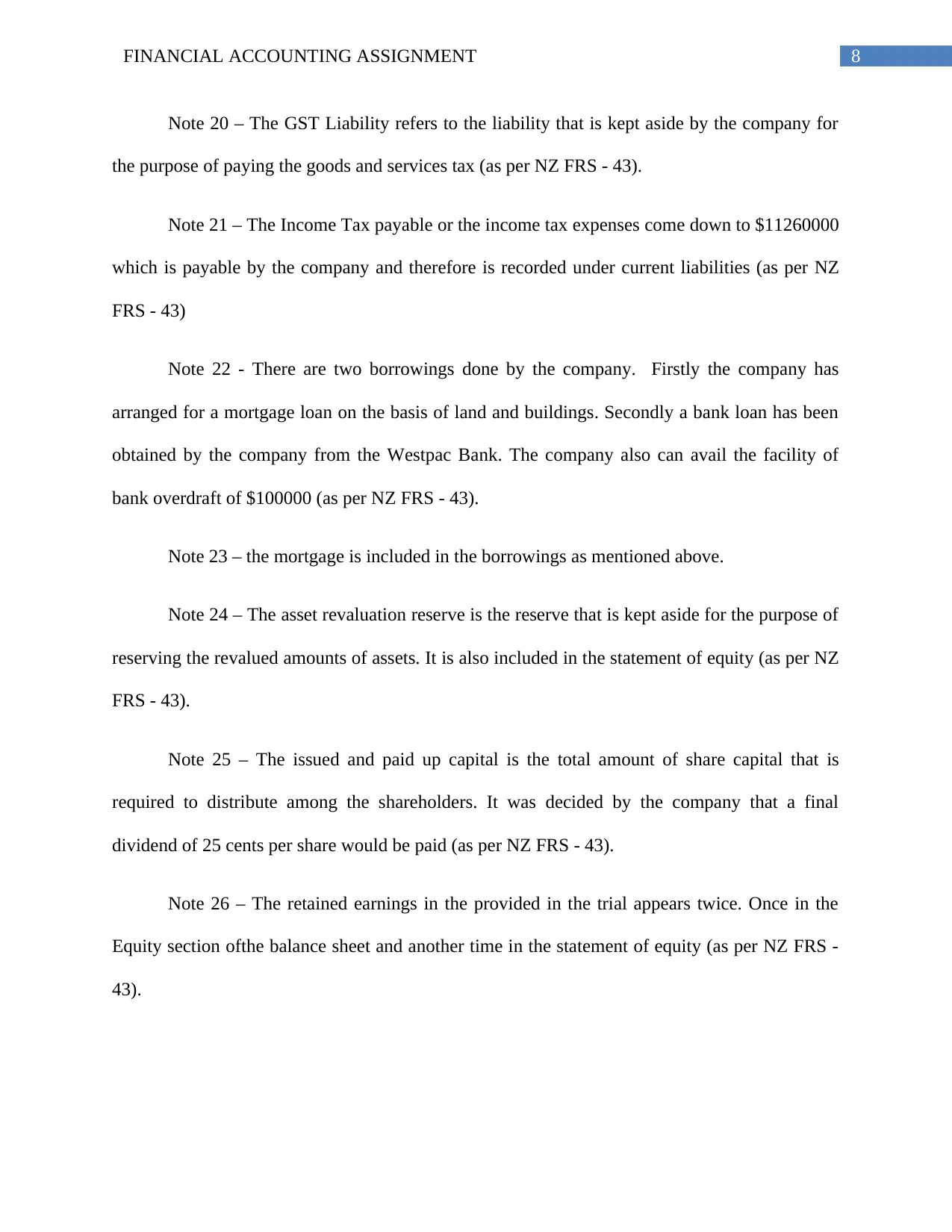
8FINANCIAL ACCOUNTING ASSIGNMENT
Note 20 – The GST Liability refers to the liability that is kept aside by the company for
the purpose of paying the goods and services tax (as per NZ FRS - 43).
Note 21 – The Income Tax payable or the income tax expenses come down to $11260000
which is payable by the company and therefore is recorded under current liabilities (as per NZ
FRS - 43)
Note 22 - There are two borrowings done by the company. Firstly the company has
arranged for a mortgage loan on the basis of land and buildings. Secondly a bank loan has been
obtained by the company from the Westpac Bank. The company also can avail the facility of
bank overdraft of $100000 (as per NZ FRS - 43).
Note 23 – the mortgage is included in the borrowings as mentioned above.
Note 24 – The asset revaluation reserve is the reserve that is kept aside for the purpose of
reserving the revalued amounts of assets. It is also included in the statement of equity (as per NZ
FRS - 43).
Note 25 – The issued and paid up capital is the total amount of share capital that is
required to distribute among the shareholders. It was decided by the company that a final
dividend of 25 cents per share would be paid (as per NZ FRS - 43).
Note 26 – The retained earnings in the provided in the trial appears twice. Once in the
Equity section ofthe balance sheet and another time in the statement of equity (as per NZ FRS -
43).
Note 20 – The GST Liability refers to the liability that is kept aside by the company for
the purpose of paying the goods and services tax (as per NZ FRS - 43).
Note 21 – The Income Tax payable or the income tax expenses come down to $11260000
which is payable by the company and therefore is recorded under current liabilities (as per NZ
FRS - 43)
Note 22 - There are two borrowings done by the company. Firstly the company has
arranged for a mortgage loan on the basis of land and buildings. Secondly a bank loan has been
obtained by the company from the Westpac Bank. The company also can avail the facility of
bank overdraft of $100000 (as per NZ FRS - 43).
Note 23 – the mortgage is included in the borrowings as mentioned above.
Note 24 – The asset revaluation reserve is the reserve that is kept aside for the purpose of
reserving the revalued amounts of assets. It is also included in the statement of equity (as per NZ
FRS - 43).
Note 25 – The issued and paid up capital is the total amount of share capital that is
required to distribute among the shareholders. It was decided by the company that a final
dividend of 25 cents per share would be paid (as per NZ FRS - 43).
Note 26 – The retained earnings in the provided in the trial appears twice. Once in the
Equity section ofthe balance sheet and another time in the statement of equity (as per NZ FRS -
43).
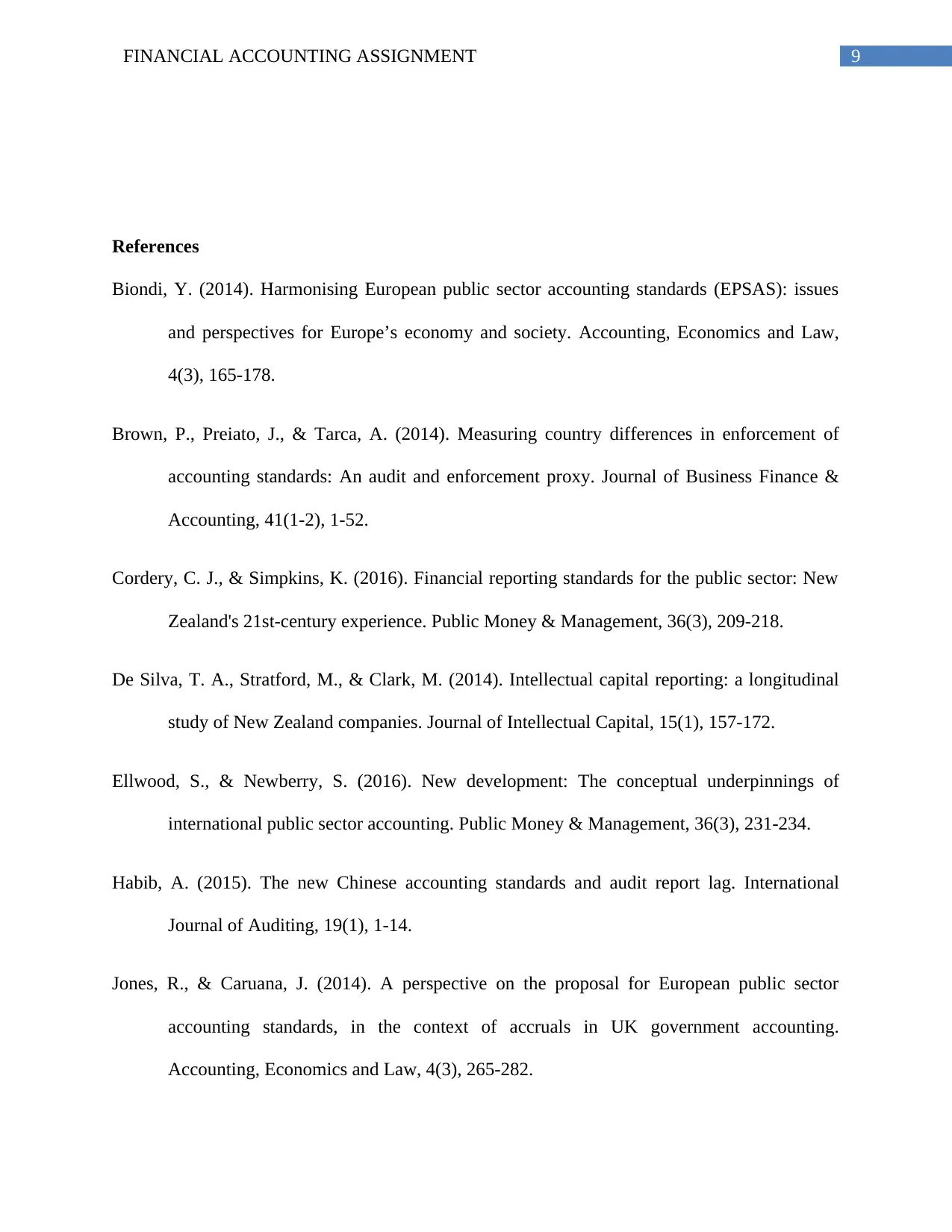
9FINANCIAL ACCOUNTING ASSIGNMENT
References
Biondi, Y. (2014). Harmonising European public sector accounting standards (EPSAS): issues
and perspectives for Europe’s economy and society. Accounting, Economics and Law,
4(3), 165-178.
Brown, P., Preiato, J., & Tarca, A. (2014). Measuring country differences in enforcement of
accounting standards: An audit and enforcement proxy. Journal of Business Finance &
Accounting, 41(1-2), 1-52.
Cordery, C. J., & Simpkins, K. (2016). Financial reporting standards for the public sector: New
Zealand's 21st-century experience. Public Money & Management, 36(3), 209-218.
De Silva, T. A., Stratford, M., & Clark, M. (2014). Intellectual capital reporting: a longitudinal
study of New Zealand companies. Journal of Intellectual Capital, 15(1), 157-172.
Ellwood, S., & Newberry, S. (2016). New development: The conceptual underpinnings of
international public sector accounting. Public Money & Management, 36(3), 231-234.
Habib, A. (2015). The new Chinese accounting standards and audit report lag. International
Journal of Auditing, 19(1), 1-14.
Jones, R., & Caruana, J. (2014). A perspective on the proposal for European public sector
accounting standards, in the context of accruals in UK government accounting.
Accounting, Economics and Law, 4(3), 265-282.
References
Biondi, Y. (2014). Harmonising European public sector accounting standards (EPSAS): issues
and perspectives for Europe’s economy and society. Accounting, Economics and Law,
4(3), 165-178.
Brown, P., Preiato, J., & Tarca, A. (2014). Measuring country differences in enforcement of
accounting standards: An audit and enforcement proxy. Journal of Business Finance &
Accounting, 41(1-2), 1-52.
Cordery, C. J., & Simpkins, K. (2016). Financial reporting standards for the public sector: New
Zealand's 21st-century experience. Public Money & Management, 36(3), 209-218.
De Silva, T. A., Stratford, M., & Clark, M. (2014). Intellectual capital reporting: a longitudinal
study of New Zealand companies. Journal of Intellectual Capital, 15(1), 157-172.
Ellwood, S., & Newberry, S. (2016). New development: The conceptual underpinnings of
international public sector accounting. Public Money & Management, 36(3), 231-234.
Habib, A. (2015). The new Chinese accounting standards and audit report lag. International
Journal of Auditing, 19(1), 1-14.
Jones, R., & Caruana, J. (2014). A perspective on the proposal for European public sector
accounting standards, in the context of accruals in UK government accounting.
Accounting, Economics and Law, 4(3), 265-282.
1 out of 10
Related Documents
Your All-in-One AI-Powered Toolkit for Academic Success.
+13062052269
info@desklib.com
Available 24*7 on WhatsApp / Email
![[object Object]](/_next/static/media/star-bottom.7253800d.svg)
Unlock your academic potential
© 2024 | Zucol Services PVT LTD | All rights reserved.
![[FULL ACCESS] Financial Statement Analysis](/_next/image/?url=https%3A%2F%2Fdesklib.com%2Fmedia%2Fimages%2Ffs%2F1dd5829f62eb4bbb90d421cba7439003.jpg&w=256&q=75)




